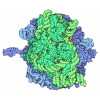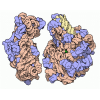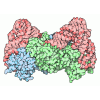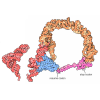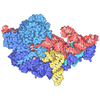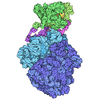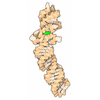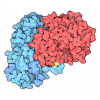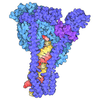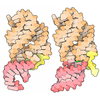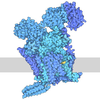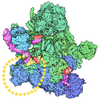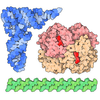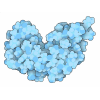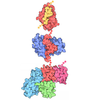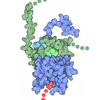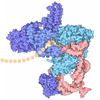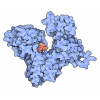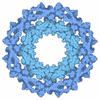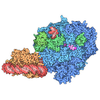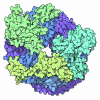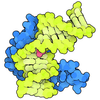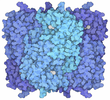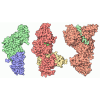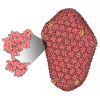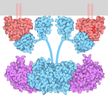+ Open data
Open data
- Basic information
Basic information
| Entry | Database: PDB / ID: 4ug0 | ||||||
|---|---|---|---|---|---|---|---|
| Title | STRUCTURE OF THE HUMAN 80S RIBOSOME | ||||||
 Components Components |
| ||||||
 Keywords Keywords | RIBOSOME | ||||||
| Function / homology |  Function and homology information Function and homology informationtranslation at presynapse / exit from mitosis / eukaryotic 80S initiation complex / negative regulation of protein neddylation / response to insecticide / optic nerve development / negative regulation of endoplasmic reticulum unfolded protein response / regulation of translation involved in cellular response to UV / oxidized pyrimidine DNA binding / response to TNF agonist ...translation at presynapse / exit from mitosis / eukaryotic 80S initiation complex / negative regulation of protein neddylation / response to insecticide / optic nerve development / negative regulation of endoplasmic reticulum unfolded protein response / regulation of translation involved in cellular response to UV / oxidized pyrimidine DNA binding / response to TNF agonist / positive regulation of base-excision repair / axial mesoderm development / positive regulation of respiratory burst involved in inflammatory response / negative regulation of formation of translation preinitiation complex / regulation of G1 to G0 transition / positive regulation of intrinsic apoptotic signaling pathway in response to DNA damage / ribosomal protein import into nucleus / positive regulation of gastrulation / protein tyrosine kinase inhibitor activity / positive regulation of endodeoxyribonuclease activity / IRE1-RACK1-PP2A complex / nucleolus organization / protein-DNA complex disassembly / positive regulation of Golgi to plasma membrane protein transport / positive regulation of intrinsic apoptotic signaling pathway in response to DNA damage by p53 class mediator / 90S preribosome assembly / retinal ganglion cell axon guidance / TNFR1-mediated ceramide production / negative regulation of DNA repair / negative regulation of RNA splicing / GAIT complex / positive regulation of DNA damage response, signal transduction by p53 class mediator / supercoiled DNA binding / neural crest cell differentiation / TORC2 complex binding / alpha-beta T cell differentiation / NF-kappaB complex / G1 to G0 transition / cysteine-type endopeptidase activator activity involved in apoptotic process / oxidized purine DNA binding / positive regulation of ubiquitin-protein transferase activity / negative regulation of intrinsic apoptotic signaling pathway in response to hydrogen peroxide / regulation of establishment of cell polarity / negative regulation of bicellular tight junction assembly / ubiquitin-like protein conjugating enzyme binding / middle ear morphogenesis / negative regulation of phagocytosis / rRNA modification in the nucleus and cytosol / erythrocyte homeostasis / Formation of the ternary complex, and subsequently, the 43S complex / cytoplasmic side of rough endoplasmic reticulum membrane / laminin receptor activity / negative regulation of ubiquitin protein ligase activity / protein kinase A binding / ion channel inhibitor activity / Ribosomal scanning and start codon recognition / homeostatic process / pigmentation / Translation initiation complex formation / positive regulation of mitochondrial depolarization / positive regulation of T cell receptor signaling pathway / macrophage chemotaxis / negative regulation of Wnt signaling pathway / fibroblast growth factor binding / lung morphogenesis / monocyte chemotaxis / male meiosis I / positive regulation of natural killer cell proliferation / positive regulation of activated T cell proliferation / negative regulation of translational frameshifting / TOR signaling / Protein hydroxylation / BH3 domain binding / SARS-CoV-1 modulates host translation machinery / regulation of adenylate cyclase-activating G protein-coupled receptor signaling pathway / iron-sulfur cluster binding / regulation of cell division / cellular response to ethanol / mTORC1-mediated signalling / Peptide chain elongation / Selenocysteine synthesis / Formation of a pool of free 40S subunits / positive regulation of intrinsic apoptotic signaling pathway by p53 class mediator / endonucleolytic cleavage to generate mature 3'-end of SSU-rRNA from (SSU-rRNA, 5.8S rRNA, LSU-rRNA) / Eukaryotic Translation Termination / ubiquitin ligase inhibitor activity / positive regulation of GTPase activity / cellular response to actinomycin D / SRP-dependent cotranslational protein targeting to membrane / Response of EIF2AK4 (GCN2) to amino acid deficiency / protein serine/threonine kinase inhibitor activity / negative regulation of ubiquitin-dependent protein catabolic process / positive regulation of signal transduction by p53 class mediator / blastocyst development / Viral mRNA Translation / negative regulation of respiratory burst involved in inflammatory response / Nonsense Mediated Decay (NMD) independent of the Exon Junction Complex (EJC) / protein localization to nucleus / GTP hydrolysis and joining of the 60S ribosomal subunit / L13a-mediated translational silencing of Ceruloplasmin expression Similarity search - Function | ||||||
| Biological species |  HOMO SAPIENS (human) HOMO SAPIENS (human) | ||||||
| Method | ELECTRON MICROSCOPY / single particle reconstruction / cryo EM / Resolution: 3.6 Å | ||||||
 Authors Authors | Khatter, H. / Myasnikov, A.G. / Natchiar, S.K. / Klaholz, B.P. | ||||||
 Citation Citation |  Journal: Nature / Year: 2015 Journal: Nature / Year: 2015Title: Structure of the human 80S ribosome. Authors: Heena Khatter / Alexander G Myasnikov / S Kundhavai Natchiar / Bruno P Klaholz /  Abstract: Ribosomes are translational machineries that catalyse protein synthesis. Ribosome structures from various species are known at the atomic level, but obtaining the structure of the human ribosome has ...Ribosomes are translational machineries that catalyse protein synthesis. Ribosome structures from various species are known at the atomic level, but obtaining the structure of the human ribosome has remained a challenge; efforts to address this would be highly relevant with regard to human diseases. Here we report the near-atomic structure of the human ribosome derived from high-resolution single-particle cryo-electron microscopy and atomic model building. The structure has an average resolution of 3.6 Å, reaching 2.9 Å resolution in the most stable regions. It provides unprecedented insights into ribosomal RNA entities and amino acid side chains, notably of the transfer RNA binding sites and specific molecular interactions with the exit site tRNA. It reveals atomic details of the subunit interface, which is seen to remodel strongly upon rotational movements of the ribosomal subunits. Furthermore, the structure paves the way for analysing antibiotic side effects and diseases associated with deregulated protein synthesis. | ||||||
| History |
|
- Structure visualization
Structure visualization
| Movie |
 Movie viewer Movie viewer |
|---|---|
| Structure viewer | Molecule:  Molmil Molmil Jmol/JSmol Jmol/JSmol |
- Downloads & links
Downloads & links
- Download
Download
| PDBx/mmCIF format |  4ug0.cif.gz 4ug0.cif.gz | 5.3 MB | Display |  PDBx/mmCIF format PDBx/mmCIF format |
|---|---|---|---|---|
| PDB format |  pdb4ug0.ent.gz pdb4ug0.ent.gz | Display |  PDB format PDB format | |
| PDBx/mmJSON format |  4ug0.json.gz 4ug0.json.gz | Tree view |  PDBx/mmJSON format PDBx/mmJSON format | |
| Others |  Other downloads Other downloads |
-Validation report
| Arichive directory |  https://data.pdbj.org/pub/pdb/validation_reports/ug/4ug0 https://data.pdbj.org/pub/pdb/validation_reports/ug/4ug0 ftp://data.pdbj.org/pub/pdb/validation_reports/ug/4ug0 ftp://data.pdbj.org/pub/pdb/validation_reports/ug/4ug0 | HTTPS FTP |
|---|
-Related structure data
| Related structure data | 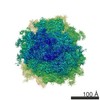 2938MC M: map data used to model this data C: citing same article ( |
|---|---|
| Similar structure data |
- Links
Links
- Assembly
Assembly
| Deposited unit | 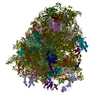
|
|---|---|
| 1 |
|
- Components
Components
-RNA chain , 5 types, 5 molecules L5L7L8S2S6
| #1: RNA chain | Mass: 1640238.125 Da / Num. of mol.: 1 / Source method: isolated from a natural source / Source: (natural)  HOMO SAPIENS (human) HOMO SAPIENS (human) |
|---|---|
| #2: RNA chain | Mass: 38998.078 Da / Num. of mol.: 1 / Source method: isolated from a natural source / Source: (natural)  HOMO SAPIENS (human) HOMO SAPIENS (human) |
| #3: RNA chain | Mass: 50449.812 Da / Num. of mol.: 1 / Source method: isolated from a natural source / Source: (natural)  HOMO SAPIENS (human) HOMO SAPIENS (human) |
| #47: RNA chain | Mass: 602752.875 Da / Num. of mol.: 1 / Source method: isolated from a natural source / Source: (natural)  HOMO SAPIENS (human) HOMO SAPIENS (human) |
| #48: RNA chain | Mass: 24231.510 Da / Num. of mol.: 1 / Source method: isolated from a natural source / Source: (natural)  HOMO SAPIENS (human) / References: GenBank: 174924 HOMO SAPIENS (human) / References: GenBank: 174924 |
+60S RIBOSOMAL PROTEIN ... , 42 types, 42 molecules LALBLCLDLELFLGLHLILJLLLMLNLOLPLQLRLSLTLULVLWLXLYLZLaLbLcLdLe...
-Protein , 4 types, 4 molecules LmSfSgSM
| #41: Protein | Mass: 14758.394 Da / Num. of mol.: 1 / Source method: isolated from a natural source / Source: (natural)  HOMO SAPIENS (human) / References: UniProt: P62987 HOMO SAPIENS (human) / References: UniProt: P62987 |
|---|---|
| #69: Protein | Mass: 18004.041 Da / Num. of mol.: 1 / Source method: isolated from a natural source / Source: (natural)  HOMO SAPIENS (human) / References: UniProt: P62979 HOMO SAPIENS (human) / References: UniProt: P62979 |
| #70: Protein | Mass: 35115.652 Da / Num. of mol.: 1 / Source method: isolated from a natural source / Source: (natural)  HOMO SAPIENS (human) / References: UniProt: P63244 HOMO SAPIENS (human) / References: UniProt: P63244 |
| #74: Protein | Mass: 14548.896 Da / Num. of mol.: 1 / Source method: isolated from a natural source / Source: (natural)  HOMO SAPIENS (human) HOMO SAPIENS (human) |
+40S RIBOSOMAL PROTEIN ... , 30 types, 30 molecules SASBSDSESFSHSISKSLSPSQSRSSSTSUSVSXSaScSdSCSGSJSNSOSWSYSZSbSe
-Non-polymers , 2 types, 245 molecules 


| #82: Chemical | ChemComp-MG / #83: Chemical | ChemComp-ZN / |
|---|
-Details
| Has protein modification | Y |
|---|
-Experimental details
-Experiment
| Experiment | Method: ELECTRON MICROSCOPY |
|---|---|
| EM experiment | Aggregation state: PARTICLE / 3D reconstruction method: single particle reconstruction |
- Sample preparation
Sample preparation
| Component | Name: HUMAN 80S RIBOSOME / Type: RIBOSOME |
|---|---|
| Buffer solution | pH: 7.6 |
| Specimen | Conc.: 0.1 mg/ml / Embedding applied: NO / Shadowing applied: NO / Staining applied: NO / Vitrification applied: YES |
| Vitrification | Instrument: FEI VITROBOT MARK IV / Cryogen name: ETHANE |
- Electron microscopy imaging
Electron microscopy imaging
| Experimental equipment |  Model: Titan Krios / Image courtesy: FEI Company |
|---|---|
| Microscopy | Model: FEI TITAN KRIOS / Date: Jan 10, 2014 |
| Electron gun | Electron source:  FIELD EMISSION GUN / Accelerating voltage: 300 kV / Illumination mode: SPOT SCAN FIELD EMISSION GUN / Accelerating voltage: 300 kV / Illumination mode: SPOT SCAN |
| Electron lens | Mode: BRIGHT FIELD / Nominal magnification: 59000 X / Nominal defocus max: 4500 nm / Nominal defocus min: 600 nm |
| Image recording | Electron dose: 60 e/Å2 / Film or detector model: FEI FALCON II (4k x 4k) |
- Processing
Processing
| Symmetry | Point symmetry: C1 (asymmetric) |
|---|---|
| 3D reconstruction | Resolution: 3.6 Å / Resolution method: FSC 0.143 CUT-OFF / Num. of particles: 24000 / Refinement type: HALF-MAPS REFINED INDEPENDENTLY / Symmetry type: POINT |
| Atomic model building | Protocol: FLEXIBLE FIT / Details: METHOD--FLEXIBLE |
 Movie
Movie Controller
Controller



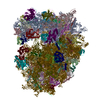
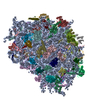
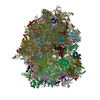

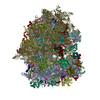
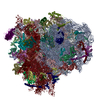
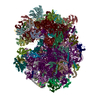


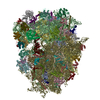
 PDBj
PDBj